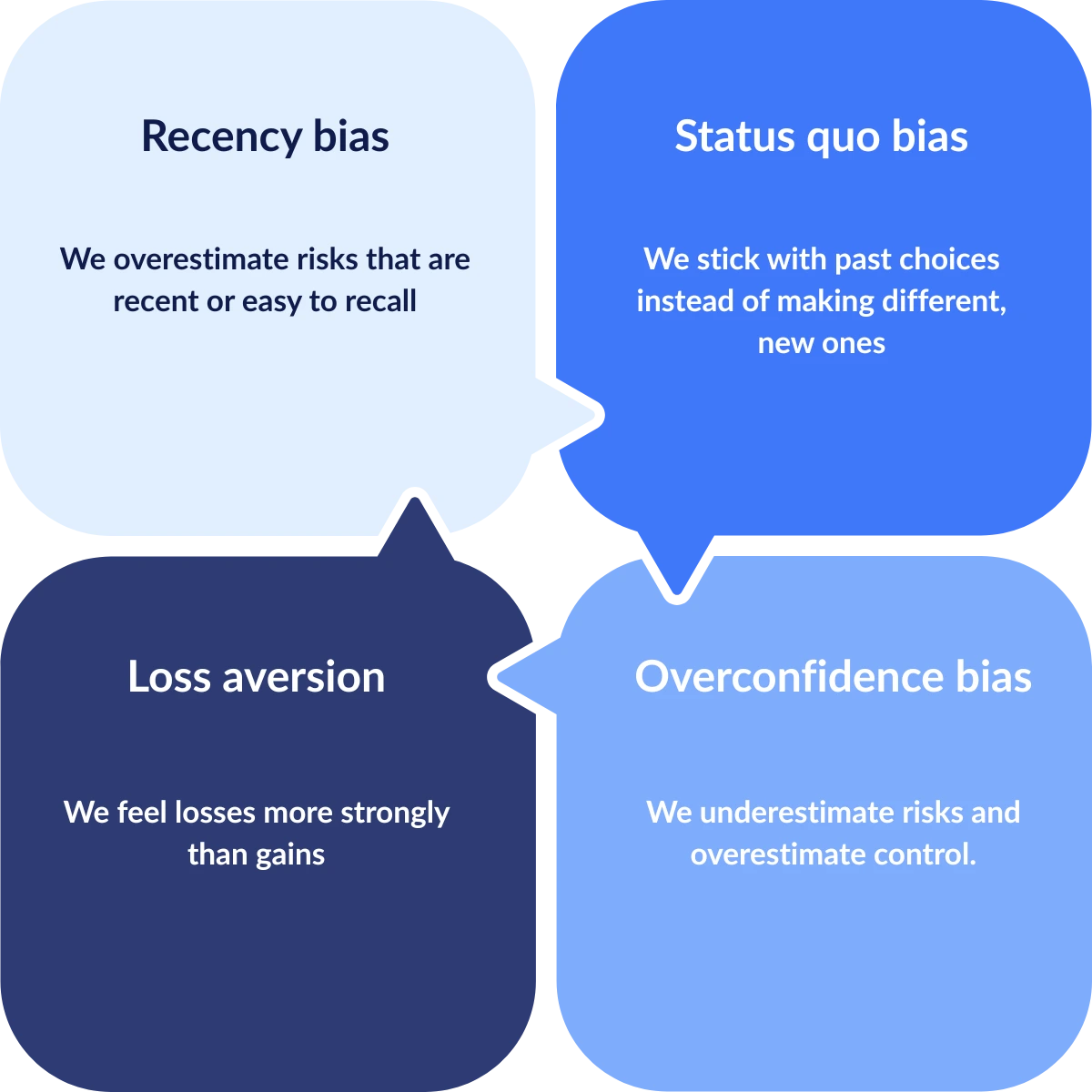Insurance is about peace of mind.
It transfers risk from individuals and businesses to insurers. When things go wrong, it protects people from financial ruin.
The problem is that even in the digital age, insurance remains difficult for most customers to buy.
In this 2-part blog series, we will explore: 1) why understanding how customers make choices in insurance matters and 2) practical ways that insurers, MGAs and brokers can design better products and buying journeys to enable customers to enjoy better, more informed insurance buying experiences.
Buying insurance is hard
Insurance cover is usually complicated.
From personal to commercial and specialty lines, customers often struggle to understand if they’re really protected against the risks that they believe they are covered for.
Interestingly, a European Commission study found that there is generally a low awareness and understanding among customers of contract terms and conditions, and that most customers don’t read policy documents but instead rely on their intuition. When products are complex, their perceived value is diminished.
Products are also often generic (rather than tailored specifically to customers) and buying journeys are usually complicated and fragmented.
Information, advice and the buying process all contribute to how well - or how badly - customers make decisions about their insurance.
From selecting the right excess, to not covering high impact risks, or even deciding whether to buy insurance at all, understanding how customers make purchasing decisions about insurance is crucial to building better insurance experiences.
Choice in insurance matters - more than you think
Decades of research shows that how choices are presented directly shapes customer decisions.
Choice architecture describes how framing decisions can impact on the choices that individuals make, for example, which options are displayed, in what order and what happens if no option is selected.
It takes account of unconscious biases and uses techniques like nudging and framing to influence decision-making.
When used correctly and responsibly, insurance product providers and distributors can use choice architecture to enable customers to make better, more informed buying decisions while still allowing customers the freedom to make their own choices.
The theory is that if insurance firms design buying experiences that help customers make more informed, confident decisions, they will buy more and better insurance.
Choice architecture and behavioural economics leverages psychology with economic decision-making. Unlike traditional economics - which assumes humans are rational - this field accepts what we all know to be true: humans are emotional, biased and imperfect decision-makers.
Insurers and reinsurers are already using these insights to:
- Create better customer experiences
- Refine product design for real needs
- Innovate in marketing and distribution
- Help customers make healthier financial decisions
For example, Swiss Re’s Behavioural Research Unit is applying these principles to assist clients, reporting 51% increased claims forms completion by anchoring policyholders to tangible actions.
Regulating choice in insurance
Regulators are choosing to take choice architecture and behavioural economics seriously too.
🇬🇧 UK
The UK’s Financial Conduct Authority explicitly considered choice when formulating Consumer Duty. The final Consumer Duty guidance explicitly requires firms to consider product and customer journey design to ensure fair value and good outcomes for customers.
The FCA has since published findings on how firms acquire customers through digital channels and how they are delivering good customer outcomes in line with Consumer Duty (whilst the findings relate to consumer credit providers, they will be of interest to all firms with a digital presence).
The findings highlight the following good practices:
- Design for different groups of customers
- Support for all customers (accessibility)
- Use friction if it can help customers with decisions
- Clear layouts of product offerings illustrating key features
- Clear language; use plain English, short sentences and reduce jargon
- Use images and videos to explain key information
- Include frontline agents in the design of digital journeys and support
- Test for good outcomes
The UK’s Competition and Markets Authority also published a discussion paper in 2022 regarding online choice architecture. As they correctly said:
“A well-designed website, app or digital service built with consumers’ interests in mind will help consumers choose between suitable products, make transactions faster, and recommend new relevant products or services.”
🇿🇦 South Africa
In South Africa, the long-term and short-term Policyholder Protection Rules establish similar principles ensuring fair treatment of customers: 1) insurers must design products to meet the needs of identified types, kinds and categories of policyholders 2) insurers must ensure policyholders are given clear information and are kept appropriately informed during the buying journey and 3) insurers must ensure that policyholders do not face unreasonable post-sale barriers to change or replace a policy, submit claims or make complaints.
Although the new Conduct of Financial Institutions Bill is still being finalised, these principles have already been incorporated into the new proposed legislation (see chapter 4 of the Bill).
Insurance buying decisions are shaped by bias
The ability of customers to make sound decisions will be affected by asymmetrical information and behavioural biases.
Biases can cause people to misjudge important facts or to be inconsistent, for example, changing their choices for the worse when essentially the same decision is presented in a different way (See the FCA’s CP21/13).
For now, we’ll focus on 4 biases:

1. Recency bias
We overestimate risks that are recent or easy to recall (similar to availability bias), essentially putting more weight on the most recent data. Good examples are after a flood or car accident, customers instinctively rush to buy cover, but if there hasn’t been a recent catastrophe, they downplay risk and may delay/forgo obtaining cover. For example, data from the US shows that life insurance application activity increased by 3.9% and 3.4% in 2020 and 2021 respectively; the peak of the COVID-19 pandemic.
Opportunity: Provide accurate, relevant data during the buying journey to help customers assess risk realistically.
2. Status quo bias
We prefer sticking with past choices rather than risking making new ones. In insurance, this often manifests as retaining the same cover or level of cover - even if our needs or asset values have changed. This may lead to customers being uninsured, or underinsured.
Opportunity: Remove the barriers for customers to review and adjust cover, for example, through policy management self-service portals. Engage with customers to demonstrate the benefits of keeping cover up to date.
3. Overconfidence bias
We underestimate risks and overestimate our control over risk events. For example, we commented on recent news that young people under 40 are delaying buying life insurance; usually this is because they perceive the likelihood of death to be low compared to older customers. Motorists are also more likely to overestimate their driving ability, and therefore the likelihood of them having an accident.
Opportunity: Technology like telematics, internet-of-things or wellness apps can help personalise risk assessment and incentivise smarter customer behaviour. In the context of motor insurance, for example, firms like Discovery Vitality and Outsurance use premium discounts to reward good driving behaviour using car telematics monitoring.
4. Loss aversion
We feel the pain of losses more strongly than the pleasure of gains. This manifests as customers preferring certainty in gains but take bigger risks to avoid losses. This can explain why customers hold on to unnecessary cover, or conversely, underinsure to avoid perceived premium “losses.”
Opportunity: Consider whether products and benefits can be framed in terms of avoided losses as well as potential gains, aligning messaging with real customer psychology.
Choice in the dark
Although behavioural insights and choice architecture can help customers, behavioural biases can also be deliberately used to push customers into making buying decisions that don’t meet their needs, or at worst bring them harm.
These are referred to as dark patterns.
Dark patterns have been written about extensively elsewhere and the European Insurance and Occupational Pensions Authority (EIOPA) has published a list of dark patterns in insurance that exploit consumer biases.
Whilst regulators are clearly concerned with policing product and platform design that harms customers, there is clearly an opportunity for firms to leverage good design to do the converse - build customer trust and satisfaction to achieve growth.
Where choice architecture meets insurance strategy
The science behind choice in insurance isn’t about manipulation. It’s about clarity and trust.
When insurers, MGAs and brokers design products and buying experiences that align with human behaviour, customers win. They make better decisions, feel more confident, and get the cover they truly need.
By extension, insurance providers and distributors win by gaining higher engagement, improved retention and a stronger customer relationship built on trust.
In a digital, AI-enabled world where insurance buying decisions are increasingly migrating to online platforms and being assisted by artificial intelligence, understanding the science of choice is no longer optional.
It’s essential.
__________________
We hope you enjoyed part 1 of this blog series. Please read part 2 next week where we unpack some practical strategies using choice architecture to design better products and customer journeys.


